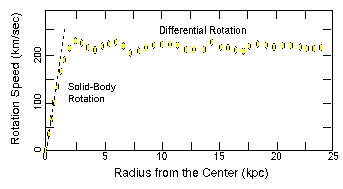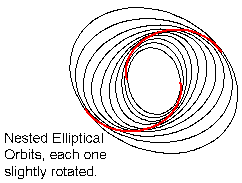

|
Astronomy 162:
Introduction to Stars, Galaxies, & the Universe
Prof. Richard Pogge, MTWThF 9:30
|
Lecture 26: Spiral Galaxies
Readings: Ch 25, Section 25-4 & 25-5
- Disk & Spheroid Components
- Rotation of the Disk
- Differential Rotation Pattern
- Measurement of Galaxy Masses
- Spiral Arms:
- Outlined by O&B Stars, HII Regions, & Gas
- Spiral Density Waves in the Disk
- Sites of recent star formation.
Spiral Galaxies
The Milky Way & Andromeda are examples of Spiral Galaxies.
All spiral galaxiess share a common structure:
- Thin Disk of stars, gas, and dust.
- Thick Spheroid of stars with little gas or dust.
All spiral galaxies have disks of varying sizes.
The spheroids of spirals, however, can vary greatly in size.
Spheroid Structure
Bulge
The bulge is the center of the galaxy where
the inner spheroid & the disk merge together. In the
bulge we find
- Many RR Lyrae stars
- A little gas & dust
Halo
The halo is the low-density outer regions of the
spheroid, where we find:
- Old metal-poor stars
- Globular clusters
- RR Lyrae Stars
Disk Structure
Thick disk of Stars
This is the main body of the disk, about 1000pc thick, composed of:
- A mix of young & old stars
- Open Clusters & loose Associations of stars
- Cepheid Stars in young clusters
Thin disk of Gas & Dust
This is a region about 100 pc thick embedded within the stellar
disk composed of
- Mostly cold atomic Hydrogen gas
- Dusty Giant Molecular Hydrogen (H2) Clouds
This gas and dust is the raw material that fuels the on-going
formation of new stars in the disks of spiral galaxies.
Rotation of the Disk
Measure using the Doppler Effect
Stars: Doppler shifts of stellar absorption lines
Ionized Gas: emission lines from HII regions
Atomic Hydrogen (HI) Gas:
- Cold H clouds emit a radio emission line at a wavelength
of 21-cm
- Can trace nearly the entire disk beyond where the stars have
begun to thin out.

Rotation Curves
The disk rotates about the center of the galaxy
Inner Parts: Solid-Body Rotation
- Orbital speed increases with radius.
- Orbital period is constant.
Outer Parts: Differential Rotation
- Orbital speed is nearly constant with radius.
- Orbital period increases with radius


Typical Rotation Speeds:
- Inner Parts:
- Rise from Zero to few 100 km/sec
- Outer Parts:
- Nearly constant at a few 100 km/sec
How fast the speed are depends on the mass of the galaxy.
Measuring Masses of Galaxies
Star or Gas cloud is held in its orbit by the mass interior
to its orbit (the matter outside makes a small contribution).
Newton's Gravity predicts:

Where:
- M(R) = mass interior to radius R
- Vrot = rotation speed
This measures the enclosed mass within an orbit. As you go
further out, you expect the enclosed mass, M(R), to increase (more of
the galaxy is inside your orbit).
Example: Milky Way
At the Orbit of the Sun:
- R=8 kpc, Vrot=220 km/sec
- Gives: M = 9.0x1010 Msun inside R=8 kpc
Gas Cloud in Outer Disk:
- R=16 kpc, Vrot=275 km/sec
- Gives: M=2.8x1011 Msun inside R=16 kpc
Measuring the rotation speeds in spiral galaxies provides us with a good
way to measure the masses of spiral galaxies, and measure how that mass
is distributed within the galaxies. As we'll see in future lectures,
those measurements held some surprises.
Spiral Arms
The spiral arms are regular, spiral-shaped patterns of hot stars, star
clusters, gas & dust that cross face of the disk.
Spiral Arm Tracers:
- O &B Stars
- HII Regions (star forming regions lit up by hot O & B stars)
- Giant Molecular Clouds
- Hydrogen Gas and Dust Clouds
These are rarely if ever found outside of spiral arms.
Sites of Active Star Formation
Recall that the Sun takes about 200 Myr to complete one orbit around the
center of our Galaxy
- The Sun lives for ~12 Gyr
- It can complete about ~50 orbits around the Galaxy before becoming
a white dwarf.
By comparison, O&B Stars only live for ~10 Myr
- O & B stars will only move ~10-20° along their oribts
before dying.
- This means they won't move very far from their birthplace.
When look at deep images of spiral galaxies, we see O&B Stars and
HII Regions strung out along the Spiral Arms
like "Beads on a String." (in the words of Walter Baade).
What are Spiral Arms?
Spiral Arms are Density Waves that pass through the general
disk of stars and gas.
Density Waves are a kind of orbital traffic jam
- Orbits crowd together in the arms, stars pile up and make
the regions look brighter.
- Gas clouds pile up, collide, fragment, and form new stars.
- O&B Stars ionize leftover gas (HII Regions), then die
before moving far from the waves.

Density Waves
Density waves pass through the disk like water waves pass over
the ocean.
- Stars move through the spiral arms.
- Gas clouds try to move through, but some are induced to form
stars (collision or compression)
We are not sure how the waves are excited:
- Tidal disturbance from a nearby companion?
- Excited by a stellar bar in the central regions?
Both of these have been implicated, and there are strong (but not
conclusive) arguments for each. Some computer simulations suggest that
spiral structure may be transitory, but given how many disk-shaped
galaxies show at least some spiral pattern, it must recur frequently.
Return to [
Unit 4 Index
|
Astronomy 162 Main Page
]
Updated: 2006 February 8
Copyright © Richard W. Pogge, All Rights Reserved.






